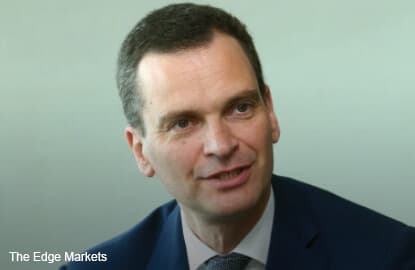
This article first appeared in Corporate, The Edge Malaysia Weekly, on June 13 - 19, 2016.
DESPITE crude oil prices inching up, jobs in the upstream oil and gas (O&G) industry remain scarce with the market still jittery, seeking more confirmation that the worst is over.
Nevertheless, for Technip SA, its Malaysian operations have been buffered by its involvement in Petroliam Nasional Bhd’s (Petronas) Refinery and Petrochemical Integrated Development (RAPID) project.
The French multinational company plays a project managerial role in RAPID through two contracts. It oversees the project and site management of the overall development as well as the utilities, interconnecting and offsite (UIO) works.
“We are deeply involved in the RAPID project in Pengerang,” Technip Asia-Pacific president Arnaud Pieton tells The Edge in an exclusive interview.
“We have several hundred people working on the project, not only on site but also here in the office. Our involvement in RAPID started when we were contracted by Petronas to do the front-end engineering and design. The whole concept was developed by Technip, together with Petronas.”
To recap, Technip announced in June 2014 that it had been awarded a project management consultancy (PMC) contract by Petronas, which entails overall project and site management, provision of project management services for specific engineering, procurement, construction and commissioning (EPCC) within RAPID. Four months later, the French oil giant, partnering Fluor Corp, a US-based engineering, procurement and construction (EPC) company, was awarded an EPC management contract by Petronas for UIO works at RAPID.
Technip declines to provide the values of the contracts. However, in a press statement announcing the PMC contract, it says a substantial onshore contract is usually worth between €250 million (RM1.15 billion) and €500 million.
Pieton says, “As part of the PMC contract, we execute the overall project on behalf of Petronas. We control the progress and all the operators. Of course, it is all under the control of Petronas ... we work very closely with them on RAPID.”
It is worth noting that Paris-based Technip, which is a giant in the O&G sector — it has a presence in 40 countries and globally recognised expertise in offshore and onshore O&G construction and engineering — has Kuala Lumpur as its Asia-Pacific operations and subsea hub.
To put things in perspective, Technip has been in the country for close to 35 years and its Malaysian operations actively export products and services to O&G companies in the region.
Its pipe manufacturing plant in Tanjung Langsat Industrial Park in Johor is the hub for flexible pipes in Asia, being only the third such facility in the world under Technip. The plant, called Asiaflex, also produces umbilicals.
“We are in Malaysia because of the long-lasting relationship that we have with Petronas. But beyond that, it is important to note that we actually do work in Malaysia for [projects] outside of the country,” Pieton says, adding that 50% of Asiaflex’s products are exported.
“We have a very large project in Indonesia, called Jangkrik, where we do some of the engineering here in Malaysia. So the engineers running the project are here in Kuala Lumpur, the manufacturing is in Johor and we export the products to operations in as far as the Gulf of Mexico.”
Technip also holds an 8.5% stake in Malaysia Marine and Heavy Engineering Holdings Bhd (MHB). Since the departure of Dominique de Soras in March last year, Technip now has only a single representative on MHB’s board — CEO Bernard di Tullio.
Speculation has been rife that the relationship between Technip and MHB has not been easy. Technip is supposed to be the brains — the technical partner — while MHB provides the yard space and workers for any onshore and offshore construction works.
But despite having a strong parent in MISC Bhd, which has a 66.5% stake in MHB, and Technip as a partner, the O&G fabricator has failed to shine and had difficulty replenishing its order book, which, in turn, resulted in the group posting a net loss of RM7.58 million in the first quarter ended March 31, 2016 (1QFY2016).
Pieton, nevertheless, sees MHB in a good light and commends the company for its capable workforce and high-end machinery. He says the investment in MHB is part of Technip’s long-term strategy, and access to MHB’s yard allows the group to bid for full EPC contracts in the region.
“We don’t own a yard. So that engagement with MHB is our way to send the message that we are serious in the offshore business. It has provided some great opportunities such as the SK316 and the Malikai TLP (tension-legged platform),” says Pieton.
“It is a mutually beneficial association and part of our long-term strategy in the region. It (MHB) owns a yard, which has high-standard equipment. It is of the standard you can find in [South] Korea. MHB has all the tools in hand to perform.”
When asked if the ecosystem in Malaysia is on a par with the other global O&G hubs, Pieton, who had worked in Houston for nine years before coming to Malaysia, says the market is well managed by Petronas. He adds that the workforce is well trained, well educated and eager.
“It can be difficult to operate in some areas in the world, but in Malaysia, the O&G market is well managed. It is possible to operate with the highest level of standard and compliance as well as the highest quality of engineering.
“For example, our Asiaflex in Johor is a complex plant with high-tech machinery producing high-tech products. We invested in training the people and [there are] knowledge exchanges, and now, the plant is run by 99% Malaysian workers and engineers,” says Pieton.
Save by subscribing to us for your print and/or digital copy.
P/S: The Edge is also available on Apple's AppStore and Androids' Google Play.